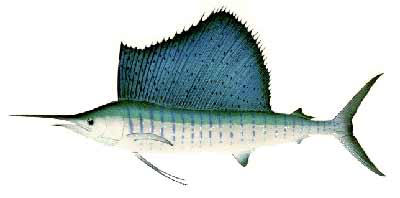Sailfish  Istiophorus platypterus
Istiophorus platypterusOther common names: spindlebeack. bayonetfish Maximum weight: 250 pounds Current all-tackle Atlantic sailfish record: 141 pounds 1 ounce -- Luanda, Angola -- February 19, 1994 Expected temperature range: 70° F to 86° F (21° C to 30° C) Description: Sailfish inhabit tropical and subtropical waters near land masses, usually in depths over six fathoms, but occasionally caught in lesser depths and from ocean piers. Pelagic and migratory, sailfish usually travel alone or in small groups. They appear to feed mostly in mid-water along the edges of reefs or current eddies. Their outstanding feature is the long, high first dorsal fin (37 to 49 total elements). The second dorsal fin is very small, with 6 to 8 rays. The lateral line along the median line of the flank is single and prominent. The bill is longer than that of the spearfish, usually a little more than twice the length of the elongated lower jaw. The vent is just forward of the first anal fin. The sides often have pale, bluish-gray vertical bars or rows of spots. The sail-like first dorsal fin is slate or cobalt blue with a scattering of black spots. The most action is found where sailfish are located on or near the surface. They eat squid, octopus, mackerel, tuna, jack, herring, ballyhoo, needlefish, flying fish, mullet and other small fishes. Their fighting ability and spectacular aerial acrobatics endear the sailfish to the saltwater angler, but they tire quickly and are considered a light-tackle species. Fishing methods include trolling with strip baits, whole mullet or ballyhoo, plastic lures, feathers or spoons, as well as live-bait fishing and kite fishing from boats using jacks, mullet and other small live baits. Recent acoustical tagging and tracking experiments suggest that this species is quite hardy and that survival of released specimens is good. Although present taxonomy suggests that the Atlantic and Pacific sailfish are the same species, some experts are not yet convinced. It has long been believed that Indo-Pacific specimens of sailfish attain a much greater size than their Atlantic counterparts. A recent study of size data from the Japanese longline fishery by Dr. Grant L. Beardsley of the National Marine Fisheries Service, Miami Laboratory, provides evidence that eastern Atlantic specimens can reach much larger sizes than previously recorded. |
||